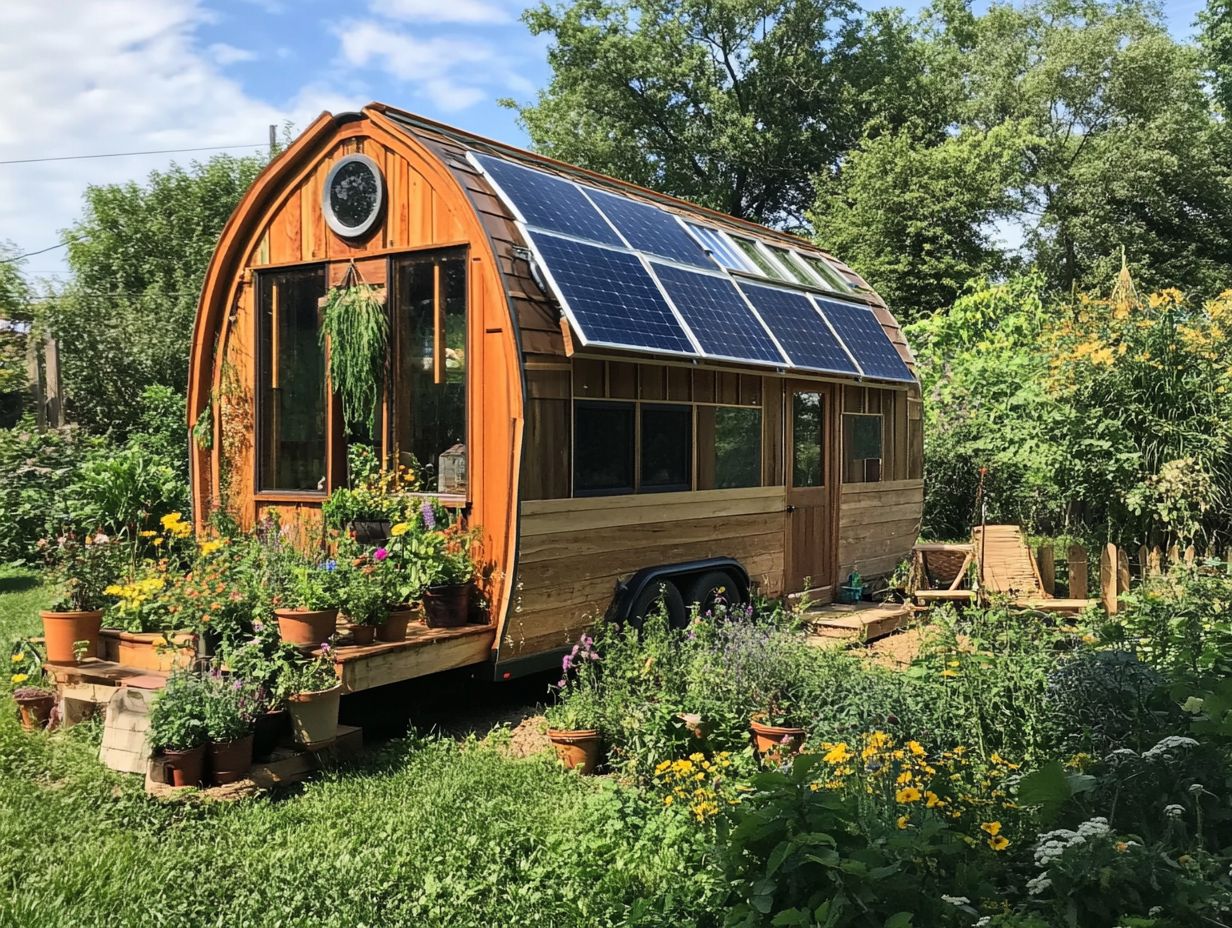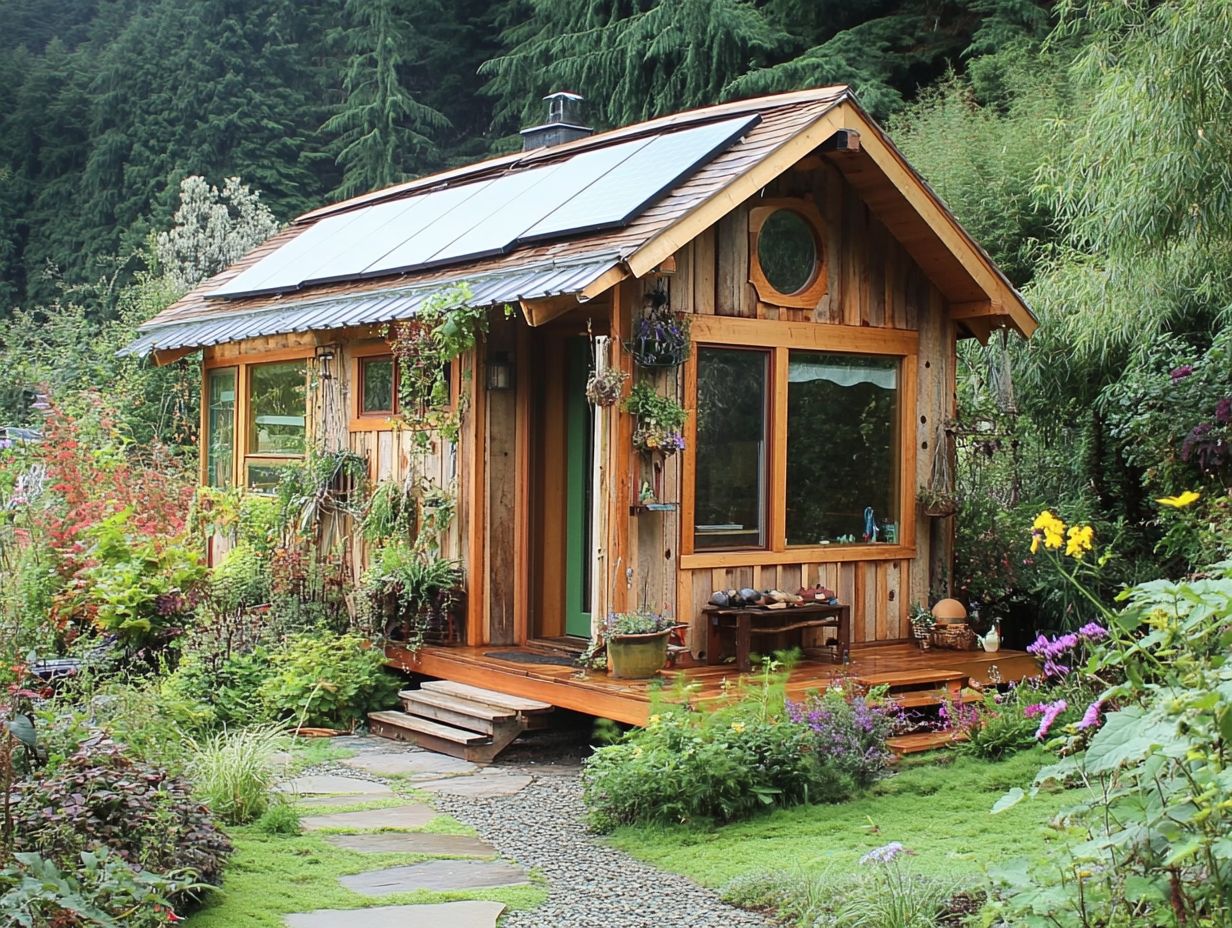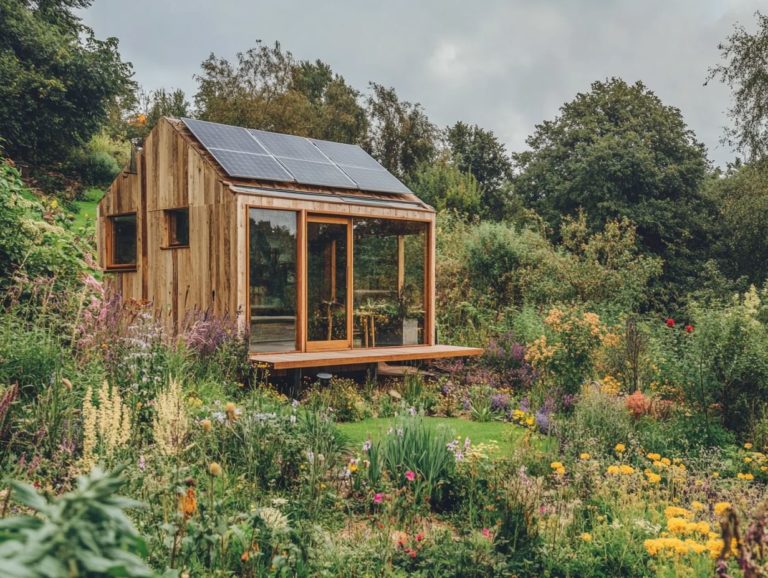Choosing the Right Sustainable Materials for Your Tiny Home
Building a tiny home transcends mere space optimization. It’s an invitation to live sustainably.
As a discerning homeowner, you increasingly seek eco-friendly solutions. Grasping what constitutes a sustainable material is essential.
Let’s explore the amazing benefits of using sustainable materials. We’ll examine everything from their environmental impact to potential cost-effective techniques.
You ll uncover crucial factors to consider when selecting building materials. We will also provide a variety of options perfectly suited for tiny homes along with practical tips for seamlessly incorporating them into your design.
Don’t wait! Discover how to create a greener and more efficient living space that truly reflects your values!
Contents
- Key Takeaways:
- Benefits of Using Sustainable Materials
- Factors to Consider When Choosing Materials
- Types of Sustainable Materials for Tiny Homes
- How to Incorporate Sustainable Materials into Your Tiny Home Design
- Frequently Asked Questions
- What are important factors to consider when choosing sustainable materials for a tiny home?
- What sustainable materials can I use in my tiny home?
- How can I ensure that the materials I choose for my tiny home are truly sustainable?
- Are sustainable materials more expensive than traditional materials?
- How can I incorporate recycled materials into my tiny home?
- What are some resources for finding sustainable materials for my tiny home?
Key Takeaways:

- Consider the climate and location of your tiny home when choosing sustainable materials. This ensures they can withstand the elements.
- Recycled and reclaimed materials add character and reduce costs. Natural and renewable materials also minimize environmental impact.
- Maximize sustainability by incorporating energy-efficient appliances. Be mindful of your budget and material availability.
What Makes a Material Sustainable?
Sustainable materials are defined by their ability to be sourced and utilized in ways that minimize environmental impact while promoting social responsibility and economic viability.
In the realm of home improvement, you ll find eco-friendly options like reclaimed wood, bamboo, and shipping containers. Each one adds unique design flair while upholding the principles of sustainable living.
These materials enhance the structural integrity of tiny homes. They contribute to waste reduction and support a low-carbon footprint, crucial for anyone involved in the tiny house movement.
Sustainable materials are the cornerstone of eco-friendly building. They create a healthier habitat for all. Take energy-efficient appliances, for instance; they re often found in tiny homes, reducing utility costs while conserving precious resources.
By adhering to updated building codes that promote sustainable practices, you ensure that new constructions emphasize longevity and environmental harmony rather than just aesthetics.
This holistic approach encourages individuals and families to adopt alternative lifestyles. These lifestyles are resourceful and reflect a commitment to ecological stewardship, paving the way for mindful living and communal well-being.
Benefits of Using Sustainable Materials
Utilizing sustainable materials in construction presents a wealth of benefits. These range from impressive environmental advantages to notable long-term cost savings.
Incorporating eco-friendly options like energy-efficient appliances and low-flow fixtures can significantly reduce your carbon footprint. This also champions effective waste management practices.
Choosing reclaimed wood and bamboo supports sustainable living. It also enhances the rustic charm of tiny homes and prefabricated homes.
Environmental and Cost Benefits
The environmental and cost benefits of using sustainable materials are remarkable, especially for tiny homes and eco-friendly constructions.
By opting for materials like structural insulated panels which help keep your home warm or cool and natural wool insulation, you can significantly cut your energy costs and lower your carbon footprint.
Integrating recycled materials can lead to impressive savings. For example, utilizing reclaimed wood can slash timber costs by up to 30%. Low-flow fixtures can help you save 20-60% on water bills, easing the pressure on local water resources.
A compelling case study from the EcoHome network showcases a tiny home constructed with 80% recycled content. This resulted in a 40% reduction in overall building expenses. These strategies not only provide financial relief but also contribute to a more sustainable environment, ensuring that future generations can thrive.
Start your journey towards sustainable living today by making informed choices about your building materials!
Factors to Consider When Choosing Materials
When you embark on a home improvement project, especially for tiny homes, several key factors require your attention to select the right sustainable materials.
Budget constraints are crucial. They guide your choices alongside the availability of eco-friendly options like recycled materials and reclaimed bricks.
It’s important to understand local building codes and consider the regional climate. This understanding can significantly influence your material selection.
Ultimately, this impacts both the sustainability and functionality of your home, helping you create a space that is beautiful and responsible.
Climate and Location

Climate and location are vital when selecting sustainable materials for tiny homes. They influence which building materials perform best in your environment.
If you’re in a humid area, natural insulation like denim cotton may be your go-to choice. For extreme temperatures, special panels that help keep your home warm or cool could be just what you need for energy efficiency.
Understanding local building codes ensures that your materials meet regulations, promoting safety and sustainability.
These regulations often address unique climatic challenges. For instance, wind resistance is crucial in hurricane-prone areas, while thermal mass requirements are important in hotter climates.
If you’re in a cold region, choosing materials with high insulation values, like straw bales or cellulose, can significantly lower heating costs.
In arid areas, reflective cool roofs can help control heat exposure. By aligning your choices with environmental conditions and local codes, you re not just building resilient structures; you re also contributing to a community-focused approach to sustainable living.
Budget and Availability
When selecting sustainable materials for your home improvement project especially in the tiny house movement budget and availability are essential.
Explore cost-effective techniques that leverage local resources like reclaimed wood and bamboo. You’ll love how these choices can save you money while promoting sustainable living.
Understanding the availability of eco-friendly options can streamline your construction process. This ensures that your project stays on schedule and within budget.
To maximize your resources, consider local builder supply yards, salvage shops, or even specialized online marketplaces for second-hand materials. These options often provide unique items that fit your budget and add character to your space.
Networking with local eco-friendly builders can also reveal tailored supplier recommendations for your area.
By balancing cost and the environmental benefits of sustainable materials, you can create spaces that minimize your ecological footprint while reflecting your personal style and values.
Types of Sustainable Materials for Tiny Homes
You have a wealth of sustainable materials available for constructing tiny homes. Each offers distinct benefits in terms of energy efficiency and ecological impact.
Consider incorporating reclaimed materials like bricks and wood, or embrace natural options such as bamboo and wool. These choices foster sustainable living and enhance the aesthetic charm of your home.
Utilizing energy-efficient materials like structural insulated panels ensures your tiny home remains functional and cost-effective, while also promoting water conservation.
Ready to choose the best materials for your tiny home? Let s get started!
Recycled and Reclaimed Materials
Recycled and reclaimed materials are at the forefront of sustainable construction for tiny homes. They offer an enticing blend of aesthetic appeal and environmental responsibility.
By incorporating materials like reclaimed wood, recycled bricks, and other eco-friendly options, you can reduce waste and support a system that recycles materials to reduce waste. Exploring unique flooring options for tiny houses can enhance the design and charm of your tiny home while helping to minimize its carbon footprint.
Take reclaimed wood, for instance. It can be transformed into flooring, furniture, or even striking accent walls, infusing warmth and character into your space. Recycled glass can add a splash of color as vibrant backsplashes or decorative elements, while salvaged metal can create one-of-a-kind fixtures or roofing options.
Sourcing these materials can turn into an adventure of its own. Imagine the thrill of treasure hunting for unique design elements from local salvage yards, eco-friendly building supply stores, or architectural salvage stores. You can uncover hidden gems that seamlessly fit into your tiny home’s design, embodying sustainable living while carrying their own stories. For those considering a tiny home, exploring the best materials for tiny house construction is essential.
This playful exploration deepens your connection to the materials you choose and reinforces your commitment to sustainability, making your home all the more meaningful.
Natural and Renewable Materials
Natural and renewable materials, like bamboo, natural wool, and other plant-based options, are increasingly celebrated for their sustainability and versatility in tiny home construction. These choices not only deliver outstanding thermal performance but also enhance your home’s unique design.
By incorporating natural materials, you embrace sustainable living while reducing reliance on synthetic products that may pose a risk to the environment. Beyond their visual appeal and performance advantages, these materials typically have lower embodied energy, meaning less energy is consumed during production and transportation.
For instance, bamboo grows rapidly and is often used in the tiny house movement, making it an exceptional choice for flooring and furniture. Wool, well-known for its insulation properties, can be effectively used in wall coverings and carpets.
Real-world examples, such as reclaimed wood in tiny homes, showcase exquisite craftsmanship and narrate a story of sustainability. Here, homeowners cleverly repurpose building materials through DIY projects, minimizing waste while creating spaces filled with character and purpose.
Low-Impact and Energy-Efficient Materials

Low-impact and energy-efficient materials are crucial in the design and construction of tiny homes. They significantly elevate sustainability.
When you incorporate items like structural insulated panels and energy-efficient appliances, including solar power options, you lower energy costs and enhance comfort essential for anyone committed to sustainable living.
By making these materials a priority, you can ensure your tiny home meets modern standards for efficiency and performance. Utilizing such materials does more than reduce your carbon footprint; it cultivates a healthier living environment that is conducive to eco-friendly practices. Additionally, consider how to choose the right windows for tiny homes to further enhance sustainability.
For instance, opting for reclaimed wood or bamboo flooring helps minimize deforestation and decreases the need for harmful chemical treatments, promoting better indoor air quality. Energy-efficient appliances, particularly those bearing the ENERGY STAR certification, can cut energy consumption by up to 50%, translating to significant savings over time, especially as utility costs continue to climb.
Consistently choosing sustainable building materials that promote water conservation can also boost the resale value among eco-conscious buyers of your tiny home. This makes it appealing to a growing market. Ultimately, these choices yield lasting benefits, encouraging responsible consumption while contributing to a healthier planet with sustainable design practices.
How to Incorporate Sustainable Materials into Your Tiny Home Design
Incorporating sustainable materials into your tiny home design requires a blend of thoughtful planning, innovative construction techniques, and creativity. This approach allows you to craft a space that is both eco-friendly and functional.
You can explore a variety of innovative construction techniques and engage in DIY projects to seamlessly integrate sustainable materials like reclaimed wood, bamboo, and energy-efficient appliances.
By embracing these practices, you have the opportunity to create a distinctive tiny home that showcases your commitment to sustainable living while minimizing your environmental footprint.
Tips for Maximizing Sustainability
Maximizing sustainability in tiny home design requires an overall plan that embraces the efficient use of eco-friendly options like composting toilets and low-flow fixtures. You can elevate your sustainability efforts by incorporating low-flow fixtures, composting toilets, and greywater systems as part of a waste management strategy that promotes water conservation and waste reduction.
These elements contribute to a smaller carbon footprint and an overall waste reduction mindset while creating a genuinely sustainable living environment.
To enhance your eco-conscious lifestyle, consider integrating energy-efficient appliances that reduce electricity usage while ensuring everyday comfort. By employing natural insulation techniques such as utilizing reclaimed materials or advanced insulation products you can minimize energy loss. This keeps your home warm in winter and cool in summer without excessive reliance on HVAC systems.
Focusing on these practical strategies enriches your living experience by fostering a healthier indoor environment supported by natural light and ventilation. This also aligns with a broader commitment to caring for the environment that embraces the tiny house movement. Living sustainably can be exciting and easy!
Frequently Asked Questions
What are important factors to consider when choosing sustainable materials for a tiny home?
Some important factors to consider include durability, energy efficiency through the use of special panels that keep your home warm and cool, cost-effectiveness with reclaimed bricks, and being environmentally friendly.
What sustainable materials can I use in my tiny home?

Examples of sustainable materials include bamboo, reclaimed wood, recycled materials like recycled metal for roofing, and natural insulation such as straw or sheep’s wool.
How can I ensure that the materials I choose for my tiny home are truly sustainable?
To ensure that the materials you choose are sustainable, look for certifications such as LEED, FSC, or Energy Star. Research the production process and environmental impact of the materials as well.
Are sustainable materials more expensive than traditional materials?
In some cases, sustainable materials may be more expensive upfront. However, they often save you money in the long run through energy efficiency and durability. The cost of sustainable materials is becoming more competitive as demand increases.
How can I incorporate recycled materials into my tiny home?
There are many creative ways to use recycled materials in your tiny home. Consider using salvaged wood for flooring and furniture, old windows for natural lighting, and recycled metal for roofing or siding. You can also repurpose materials from thrift stores or yard sales.
What are some resources for finding sustainable materials for my tiny home?
Resources for finding sustainable materials include local salvage yards, eco-friendly building supply stores, and online marketplaces for reclaimed and recycled materials. Reach out to sustainable home builders or join online communities for tiny home builders to get recommendations and advice.
Start your tiny home journey today!






